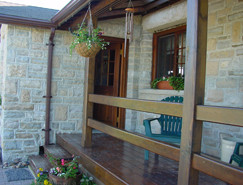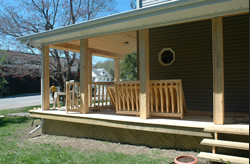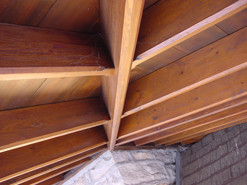 The old-time, roof-covered open porch, or verandah, is one traditional architectural feature that’s staging a comeback these days. I’m a big fan of verandahs, mostly because I feel good when I’m on one. The practical side of my brain follows along by pointing out all the technical advantages verandahs offer, too. Windows, doors and siding all last longer when under the protection of a roof. And even the floor itself will outlive a comparable deck because the roof partially deflects rain and sunlight, reducing the toll these take on wood and finishes.
The old-time, roof-covered open porch, or verandah, is one traditional architectural feature that’s staging a comeback these days. I’m a big fan of verandahs, mostly because I feel good when I’m on one. The practical side of my brain follows along by pointing out all the technical advantages verandahs offer, too. Windows, doors and siding all last longer when under the protection of a roof. And even the floor itself will outlive a comparable deck because the roof partially deflects rain and sunlight, reducing the toll these take on wood and finishes.
Eavestrough-equipped verandahs are also helpful at drying up basement leaks, since they typically shed rain 6 to 8 feet away from the house. Successfully adding a verandah onto your house (or directing a professional to add one for you) starts with an understanding of key design and construction basics.
Design Considerations
 Does your house have what it takes to sport a traditional verandah? The best place to start your quest for a pleasing design is to search for other houses with verandahs you like. Most will probably be 1 1/2 or 2 storey homes, but verandahs can also be added to bungalows too. The two most important visual details are floor width and roof slope. It’s easy to make a mess if you get these key details wrong for your situation, so do your homework. In fact, the issue of proportions is crucial enough that you should ask permission to measure these details on houses around your neighbourhood that strike your fancy. You’ll usually find that verandahs are far narrower than what you’d expect from an uncovered deck. Don’t let this worry you. Six to eight foot-wide verandahs are typical on homes where a deck twice as wide might otherwise be installed.
Does your house have what it takes to sport a traditional verandah? The best place to start your quest for a pleasing design is to search for other houses with verandahs you like. Most will probably be 1 1/2 or 2 storey homes, but verandahs can also be added to bungalows too. The two most important visual details are floor width and roof slope. It’s easy to make a mess if you get these key details wrong for your situation, so do your homework. In fact, the issue of proportions is crucial enough that you should ask permission to measure these details on houses around your neighbourhood that strike your fancy. You’ll usually find that verandahs are far narrower than what you’d expect from an uncovered deck. Don’t let this worry you. Six to eight foot-wide verandahs are typical on homes where a deck twice as wide might otherwise be installed.
Even after seeing and measuring several verandahs you like, adding one to your house can still be an aesthetic gamble because you’re making such a large visual change to the structure. A simple way to see what you’ll be getting is by building a small, scale model using low-tech materials like cardboard, foam board, tape and hot-melt glue. The aim is to know exactly what you’re adding to your house visually before any lumber is cut. It’s wonderful to move ahead with the confidence that this exercise inspires.
Adding a verandah can also darken the inside of your home if its roof shades major windows. Eliminate this problem by putting skylights in the verandah roof, right over those important windows.
Construction Details
 You’ll have to invest more into the footings of a verandah than those of a deck, because the seasonal wood movement that could occur with a poor foundation is more critical when you’re supporting a roof. The best type of verandah footings are concrete piers that extend down below the frost line under each roof support post– 48 inches is a safe footing depth in most places. Corrosion-proof metal brackets, called “post saddles’’, set into the top of these piers when the concrete is still wet form an anchor for the 6×6 or 8×8 posts that’ll support the roof. It’s best to also bolt these brackets down to the piers after the concrete has cured to help resist the strong upward force of wind when it gets under the verandah roof. Don’t use pre-cast concrete deck feet to support a verandah because the downward loads are too great and they offer no resistance to wind lift.
You’ll have to invest more into the footings of a verandah than those of a deck, because the seasonal wood movement that could occur with a poor foundation is more critical when you’re supporting a roof. The best type of verandah footings are concrete piers that extend down below the frost line under each roof support post– 48 inches is a safe footing depth in most places. Corrosion-proof metal brackets, called “post saddles’’, set into the top of these piers when the concrete is still wet form an anchor for the 6×6 or 8×8 posts that’ll support the roof. It’s best to also bolt these brackets down to the piers after the concrete has cured to help resist the strong upward force of wind when it gets under the verandah roof. Don’t use pre-cast concrete deck feet to support a verandah because the downward loads are too great and they offer no resistance to wind lift.
Verandahs built 60, 70 and 80 years ago typically had a wooden ceiling applied to the underside of roof rafters, but I’ve noticed that this can promote rot by trapping rainwater if it leaks past shingles and flashing. It also adds a lot of expense in materials and labour. An easier alternative is to frame the roof of your verandah with standard 2×6’s or 2×8’s, sporting routed edges to improve their looks. It’s amazing how pretty construction-grade lumber can look when it’s treated with a little artistic care. Since the underside of the verandah’s roof sheathing remains visible in this design, it’s best to use solid wood planks for the roof deck, rather than plywood. Pre-finishing the rafters and roof boards before installation saves you the enormous hassle of overhead finishing.
Verandahs are more work to build than a deck, but they add so much more enjoyment to your home. Once again, it’s a case of a little more effort delivering a lot more value.